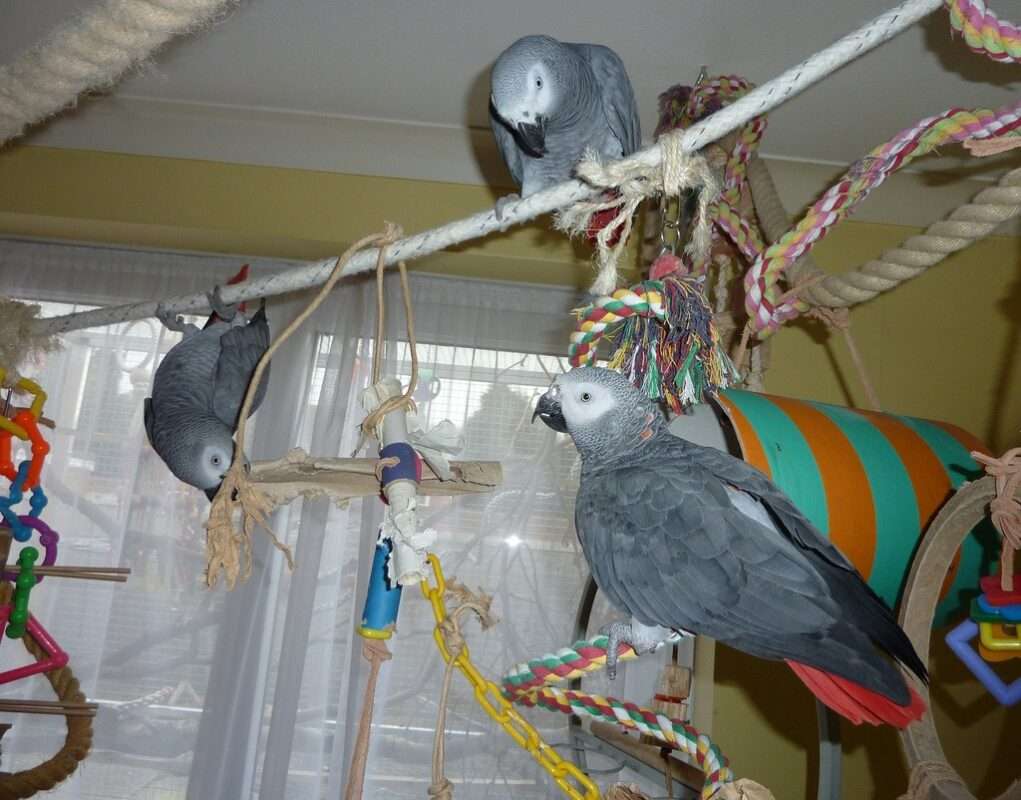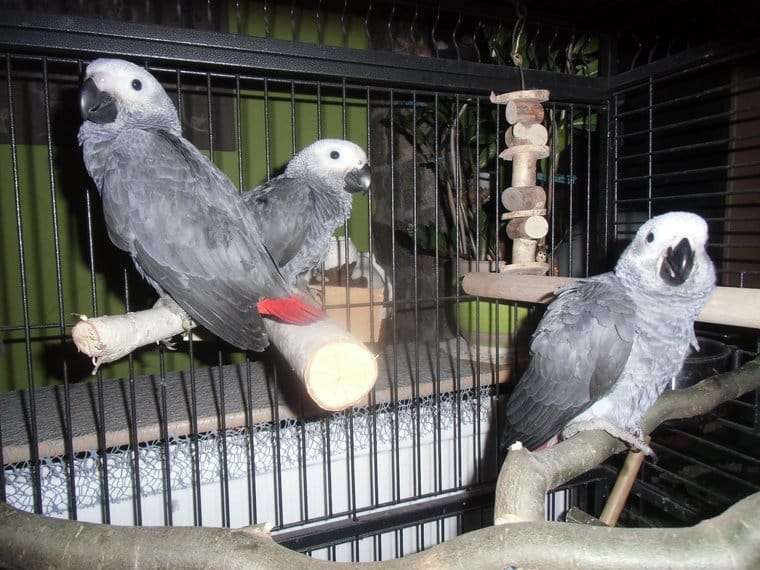African grey parrots are famous for their intelligence and vocabulary. They mimic human speech perfectly well and can also learn to answer questions, the African grey expresses affection and use things like deductive reasoning. Some studies say that their intelligence is equivalent to a kindergartner!
If you’ve ever seen an African Grey parrot, then you know that they are beautiful birds, but did you also know that they are capable of amassing vocabularies of up to 1,000 words or more, and using the words that they learn to speak in context? To say that these birds are intelligent would be an understatement, and the best part is, that’s not the only thing that makes the African Grey parrot so special.
African grey parrots are beautiful, majestic wild animals. They are also among the most popular bird species kept as a pet in Europe, the USA, and the Middle East where they are seen as attractive pets due to their long life, ability to mimic human speech, and overall intelligence.
Read on to discover a few of the most interesting and exciting facts about African Grey parrots, including their origin, information on the various subspecies of African Grey, and more. Learning more about these incredible birds may inspire you to get involved with the species in a larger capacity, be it through adoption, research, or conservation.
One of the most popular “exotic pets” in the world, African grey parrots lead complex, active social lives in their natural habitat

Are you ready to learn even more African grey parrot facts? Let’s get started.
Lifespan/ African Grey Can Live for a Very Long Time:-
African grey parrots have an extremely long lifespan – they live an average of 60 – 70 years, with some birds reaching 80 years old! Because they have such long lives, they often outlive their human owners, meaning that they may have to go through traumatic rehoming several times in their life.
African grey parrots have been known to live for up to even 80 years in captivity, so it’s imperative that those who adopt them can commit to a lifetime of living with a bird. African grey parrots are too emotionally sensitive to be able to handle being bounced from owner to owner, but sadly many of them do have several homes throughout their lifetimes because people rush into adopting them without fully thinking it through. You can help put an end to situations like these by helping to educate people about African grey ownership, and by making sure that you set a good example for bird owners who might be interested in adopting such a parrot.
Clever/ African Grey are Among the Most Intelligent Bird Species:-
Besides being one of the most popular pet bird species, African grey parrots are also one of the most intelligent. Fully grown African greys have shown in some research samples to have the same intelligence level as a toddler. Research has also found that they can identify, request, refuse, categorize, and quantify more than 80 different objects, and respond to questions concerning concepts of colour and shape.
It has been said that these impressive birds have the mental and emotional capacities of a 5-year-old human child. There’s a whole list of impressive things that African grey parrots can do. Their skills include:
Mimic human speech
Identify shapes and colors
Learn number sequences
Ask unprompted questions
Hold entire conversations with their owners
They’re even capable of things like deductive logic and probabilistic reasoning. They rank up there with dolphins and gorillas in terms of brainpower.
African Grey Fly Boy:-
African grey parrots are capable flyers, but they don’t always do it as much as other birds. For example, they use their beaks and claws to move around tree canopies rather than flying from branch to branch. In their natural habitat, African grey parrots can travel up to 10 kilometers a day. No domestic setting can match flying free through the luscious African forest.
They’re Monogamous:-
It isn’t known whether African grey parrots mate for life, but they do form monogamous pairs that stick together for multiple mating seasons. This species of parrot are monogamous, which means that they only mate with one companion at a time. They’ll perform courtship rituals before accepting each other and laying eggs together, and both parents will feed, shelter, groom, guard and socialize their babies. This is quite different from other bird species where the mom does everything and the dad might not even stick around for the hatching.
In nature, they also display behaviors such as bi-parental care (both parents look after their little chicks) and show altruistic behaviors such as grooming each other and regurgitating food to feed others. With African grey parrots, both parents are equal partners in mating and child-rearing.
African Grey Parrot Nesting & Laying Eggs
When it’s time to nest, African grey parrots move into tree holes. The cover can help to protect their eggs from predators. They usually hop into unoccupied tree holes, but they’ve been known to steal the nests of woodpeckers and other small birds.
The female African grey parrots lay eggs 1 – 2 times per year. A female grey lays three to five eggs, which she incubates for 30 days while being fed by her mate. the hatch-lings will weigh just 0.42 – 0.49 ounces at birth. They’ll be red, bald, wrinkled, and hairless. They’ll develop a soft fuzzy layer of down before their first feathers start growing.
The female will hide in her tree hole and sit on them the entire time. She won’t move from her post; the male will do all of the foragings, and he’ll come back to feed and guard her while she protects the all-important eggs. Once the babies are born, mom and dad will be active parents together. Their main priority will be protecting the small, vulnerable hatchlings from predation, but they’ll also need to teach them how to eat, fly, forage, and vocalize
The adults defend their nesting sites. Both parents help take care of the chicks until they can go off on their own.
African grey parrots reach sexual maturity between 3 – 5 years. Males and females mature at the same rate.
The eggs of an African grey parrot are white and tiny. Their eggs are also a favorite of monkeys. This is one of the reasons why mothers guard their nests so fiercely; they never know when they might be sharing a tree with a long-fingered predator. Pythons also eat parrots and their eggs.
Strong Bond:-
It depends on your definition of “good.” African grey parrots are intelligent creatures that can make fun, active and playful pets. But they’ll also require a lot of time and attention. You can’t just lock them in a cage and forget about them. They won’t let you!
Because they are so intelligent, African grey parrots form very strong bonds with their owners and can be quite emotionally needy.2 Due to this trait, they do best with owners who can devote ample time to handling and socializing with them daily. Also, African grey parrots need a lot of exercise to keep their strong muscles toned and maintain adequate physical condition. This means that they must be able to spend several hours per day outside of their cages, playing in supervised, “parrot-proof” areas.
For example, African grey parrots are easily bored. If you aren’t providing them with enough stimulation, they might start bothering you with loud chatter and movement. They’ve also been known to take out their boredom on other birds, so they can become a bit of a problem child for you if you own a whole menagerie. If you’re thinking of adopting an African grey parrot, make sure that you’re ready for a full-time, long-term commitment. They can be a lifelong companion, but you have to be willing to put in the work.
Quick Facts About African Grey:-
As its name indicates, the African grey is a mottled grey-colored, medium-sized parrot. It has a large black bill and white mask enclosing a yellow eye and has a striking red vent and tail. Females have a pale gray crown with dark gray edges, a gray body, and scarlet tail feathers. The male looks similar to the female but becomes darker with age.
Size:- Approximately 33 cm (13.2 in.)
Weight:- Approximately 400 g (14 oz.)
Diet:- Includes fruit, seeds, buds, nectar, and pollen; occasionally insects or other meat will be eaten
Incubation:- 28 days
Clutch Size:- 2 to 4 eggs
Fledging Duration:-12 weeks
Sexual Maturity:- 4 to 7 years
Status:- IUCN: Endangered
CITES: Appendix I
USFWS: Not listed
Scientific Classification
Common Name:- African grey parrot
Kingdom:- Animalia
Phylum:- Chordata
Class:- Aves
Order:- Psittaciformes
Family:- Psittacidae (true parrots)
Genus Species:- Psittacus (parrot) Erithacus (a solitary bird that can be taught to speak)
African grey parrots have an extremely long lifespan – they live an average of 60 years, with some birds reaching 80 years old! Because they have such long lives, they often outlive their human owners, meaning that they may have to go through traumatic rehoming several times in their life.


